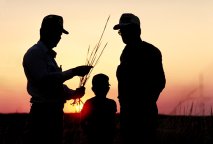Personal Protective Equipment For Farmers
Background
- Personal protective equipment can significantly reduce the number and severity of farm accident-related injuries and illnesses.
Tips
- Wear a hard hat when performing construction work, trimming trees, repairing machinery, and doing other jobs where there's risk of head injury.
- Wear a bump cap for everyday farm tasks.
- Wear impact-resistant safety eyewear when doing jobs dust-raising or potentially eye damaging types tasks.
- Use acoustic ear muffs or inserts when operating noisy farm machinery and power tools.
- Use a dust mask or filter respirator when working in dust, spray painting, or handling moldy forage.
- Use a gas mask or chemical cartridge respirator when applying pesticides or ammonia fertilizers.
- Wear a self-contained breathing device in any place where there could be toxic fumes or insufficient oxygen.
- Protect hands by wearing gloves or applying barrier cream; however, don't wear gloves around machinery moving parts.
- Protect feet with safety shoes or boots with slip-resistant soles.
- Wear impervious clothing when using toxic or irritating chemicals to protect skin.
Summertime Farm Safety Tips
The National Safety Council's Farm Department and the U.S. Department of Agriculture have come up with four themes for safety emphasis during the summer months: Safe Harvest of Small Grain; Water Recreation; PPE (Personal protective equipment) Protects; and Safety Belts Save Lives. The variety of subjects reflects the variety in the lives of farm families during this busy season of work, play and travel. The Council has provided farm families with the following safety tips:
- For safe harvesting, it says to operate and maintain harvesting equipment as directed in instruction manuals; make sure workers are competent and know how to do the job safely; keep all machine shields and guards in place while operating and stay clear of unshielded moving parts
Also, stop the machine and turn off the engine before unclogging, inspecting or servicing; adjust machine ground speed to surface, crop and visibility conditions; keep children away from the harvesting equipment, the combine's discharge auger, grain bins and tanks; and wear protective safety gear.
- In the area of water recreation, the Council advises farm and ranch residents to swim or at least to float well enough to survive in water; poor or beginning swimmers stay out of deep water; step carefully on docks, banks, and at poolside to avoid slipping; supervise small children in the water; have fully-inflated rescue equipment handy; learn first aid and safe boating rules; and limit drinking while boating.
- Personal protective equipment can reduce the number and severity of farm accident injuries and occupational illnesses, the Council notes. Some key safety points for farm workers include protecting the head with a hard hat when performing construction work, trimming trees, repairing machinery and doing other jobs with head injury risks; wear a bump cap for everyday farm tasks; protect vision with impact-resistant safety eyewear; protect hearing with acoustic ear muffs or inserts when operating noisy farm equipment; protect lungs with respiratory equipment appropriate for the job and hazards; use a dust mask or filter respiratory equipment appropriate for the job and hazards; use a dust mask or filter respirator when working in dust, spray painting or handling moldy hay.
Also, use a chemical cartridge respirator or gas mask when applying pesticides or ammonia fertilizers; use a self-contained breathing device in places with toxic gases or insufficient oxygen; protect hands with gloves or barrier creams; don't wear gloves near moving parts; protect feet with safety shoes or boots with slip-resistant soles; and, protect skin with impervious garments when using toxic or irritating chemicals.
- In the area of auto safety, the Council strongly suggests always fasten a safety belt, both lap and shoulder restraints, when driving or riding in a car; insist that passengers wear safety belts and make sure child safety seats and infant car carriers are of good quality and meet applicable safety standards. Also, replace old seat belts with new ones of the best quality available; don't disengage safety belt "reminder" devices such as buzzers or lights and, use a safety belt when operating farm tractors equipped with roll protection.
Last updated: 18-May-2006 11:08 AM


 Designed and maintained by the
Designed and maintained by the